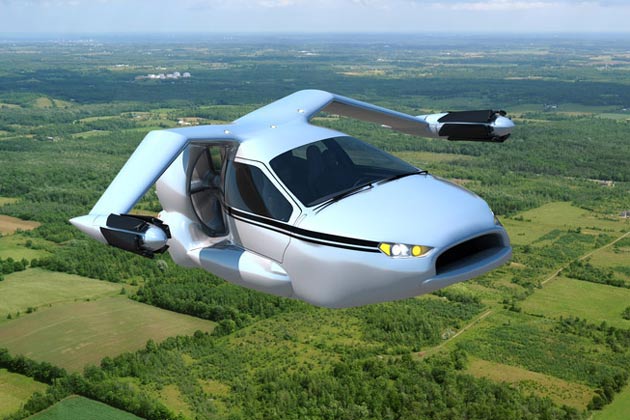Remember how Ron sneaks away his dad’s magical flying car to get Harry Potter? And how we wondered if ever we could do the same! While the street-legal airplane Terrafugia Transition was a step closer to that wonder, it’s this next-generation Terrafugia TF-X that packs in more conviction as compared to its predecessor. The TF-X holds potential to become a direct replacement to automobile, while the Transition with its rectangular wings was more inclined towards being a conventional airplane that requires runway to take-off and land.

Indeed, TF-X is a hybrid, in multiple domains. Though it flutters around like a fixed-wing aircraft, the four-seating vehicle could take-off and land vertically, thanks to the collapsible & electrically-powered rotors mounted on the ends of its fold-up wings. They derive energy off a electric battery pack whose make and composition is yet to be determined, which could be recharged via an electrical out-port or a gas turbine engine that powers a rear-mounted propeller while the TF-X flies. While on the ground, the TF-X wheels are propelled by electric motors, which again suck power off the battery or get their energy boost from an in-series hybrid mode where the turbine generates electricity once the battery charge is depleted.

Users will need a pilot’s license if they wish to fly the TF-X, but Terrafugia assures that a 5-hour training shall be enough to learn all the vehicle’s operations. But you won’t have to do much of the flying. As per FAA’s NextGen program, which needs the aircraft to be equipped with satellite transponders sending their precise location to a centralized air traffic management system starting in 2020, the TF-X shall pretty much be flying on its own. All the pilot has to do is enter a destination in the navigation system and relax. If at all any major mechanical failure occurs during its flight, there’s an inbuilt parachute that’ll bring the TF-X safely to the ground.
And you don’t want to fly this vehicle off your driveway, for the powerful prop wash of the TF-X requires a clear 100-foot diameter range for takeoffs and landings, and these zones need to be regulated like the present helicopter pads. But anyways, all this flying-off will take at least 8 to 10 more years, as even Transition is a couple years away from the production house (by early 2015 the company plans to deliver these vehicles).
But not the ones to keep our excitement in check, are we? Ha! Howzzat, Weasely?
Remember how Ron sneaks away his dad’s magical flying car to get Harry Potter? And how we wondered if ever we could do the same! While the street-legal airplane Terrafugia Transition was a step closer to that wonder, it’s this next-generation Terrafugia TF-X that packs in more conviction as compared to its predecessor. The TF-X holds potential to become a direct replacement to automobile, while the Transition with its rectangular wings was more inclined towards being a conventional airplane that requires runway to take-off and land.
Indeed, TF-X is a hybrid, in multiple domains. Though it flutters around like a fixed-wing aircraft, the four-seating vehicle could take-off and land vertically, thanks to the collapsible & electrically-powered rotors mounted on the ends of its fold-up wings. They derive energy off a electric battery pack whose make and composition is yet to be determined, which could be recharged via an electrical out-port or a gas turbine engine that powers a rear-mounted propeller while the TF-X flies. While on the ground, the TF-X wheels are propelled by electric motors, which again suck power off the battery or get their energy boost from an in-series hybrid mode where the turbine generates electricity once the battery charge is depleted.
Users will need a pilot’s license if they wish to fly the TF-X, but Terrafugia assures that a 5-hour training shall be enough to learn all the vehicle’s operations. But you won’t have to do much of the flying. As per FAA’s NextGen program, which needs the aircraft to be equipped with satellite transponders sending their precise location to a centralized air traffic management system starting in 2020, the TF-X shall pretty much be flying on its own. All the pilot has to do is enter a destination in the navigation system and relax. If at all any major mechanical failure occurs during its flight, there’s an inbuilt parachute that’ll bring the TF-X safely to the ground.
And you don’t want to fly this vehicle off your driveway, for the powerful prop wash of the TF-X requires a clear 100-foot diameter range for takeoffs and landings, and these zones need to be regulated like the present helicopter pads. But anyways, all this flying-off will take at least 8 to 10 more years, as even Transition is a couple years away from the production house (by early 2015 the company plans to deliver these vehicles).
But not the ones to keep our excitement in check, are we? Ha! Howzzat, Weasely?